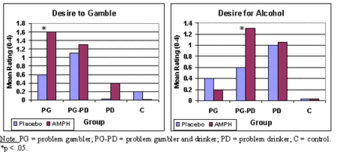The WAGER Vol. 9(23) – A Primer on Priming: Betting on the Fast Track
Imagine catching a whiff of fresh-baked cookies. Whether the cookies you smell are oatmeal or sugar or chocolate, that whiff can set off a craving for your favorite cookie variety. This phenomenon of a small taste inducing a craving for a similar substance is known in the addictions as priming. In fact, priming drug users with a similar drug to their drug of choice (e.g., priming regular cocaine users with another stimulant such as amphetamines) produces drug-seeking or drug-taking of their chosen drug. This week’s WAGER reviews a paper by Zack and Poulos (2004) that tests whether this priming effect holds true for gambling. Because gambling is comparable to a chemical stimulant (i.e., producing similar affective, behavioral, and neurological reactions – see Zack & Poulos, 2004), the authors examined the effect of an amphetamine prime (AMPH) on problem gamblers’ desire to gamble.
Zack and Poulos (2004) used newspaper advertisements to recruit 36 participants, ten of whom were primarily problem gamblers, (i.e., scores of 5 or higher on the South Oaks Gambling Screen but no drinking problems), eight of whom primarily had drinking problems (i.e., scores of 9 or higher on the Alcohol Dependence Scale but no gambling problems), six of whom had gambling and drinking problems, and twelve of whom were controls (i.e., no gambling or drinking problems). Participants attended two identical sessions one week apart during which they first received a prime of AMPH or placebo and then, 90 minutes later, completed a self-report measure of their current feelings and urges. All participants received AMPH during one session and placebo during the other session, administered in an identical fashion so that participants were unaware that the prime differed. The self-report measure (administered at both sessions) included questions on a five point scale about participants’ desire to gamble and drink alcohol, and questions on a percent scale (i.e., 0-100%) about participants’ confidence in their ability to resist gambling or alcohol.
Because AMPH and gambling are stimulants and alcohol is a central nervous system depressant1, alcohol is in a different class of psychoactive substance than AMPH and gambling. Therefore, Zack and Poulos predicted that the AMPH prime would have an effect on the urges of problem gamblers, but not on those of people with drinking problems.
Figure 1. Gambling Urges after AMPH or Placebo Prime (Zack & Poulos, 2004)
As Figure 1 shows, problem gamblers reported significantly more desire to gamble after administration of AMPH than after placebo, t(32) = 2.63, p < .05, an increase not reported by other groups2. As Figure 1 also shows, problem gamblers with drinking problems did not report stronger desire to gamble but did report stronger desire for alcohol after AMPH than after placebo, t(32) = 2.19, p < .05. No other group reported an increase in desire for alcohol. An analysis of covariance controlling for baseline confidence differences in the placebo condition revealed that both problem gamblers and problem gamblers with drinking problems also reported lower confidence to resist gambling after AMPH as compared to placebo, F(1,31) = 5.18, p < .05. Non problem gamblers reported no such decrease in confidence. Confidence to resist alcohol did not differ between AMPH and placebo conditions for any group.
From these results, Zack and Poulos (2004) concluded that amphetamine was a selective prime for problem gamblers. Overall, the drug changed the urges and reported resistance to gambling of problem gamblers but not of people without gambling problems. AMPH also increased desire to drink in those problem gamblers with drinking problems and desire to gamble in those without drinking problems. The findings imply that the AMPH prime affected only participants addicted to some extent to a stimulating activity (i.e., gambling as opposed to alcohol), and increased urges related to whichever addiction was stronger in those participants. For example, a problem gambler with drinking problems might report only increased urges to drink, but a problem drinker without gambling problems will not report increased urges to drink or gamble.
The largest limitation of these results is the small sample size. There were only six to twelve participants in each group and the authors do not describe what sort of newspaper ad led to participant recruitment. In addition, as the authors note, alcohol has dose related properties of both a depressant and a stimulant, so might not be the ideal comparison substance. In low doses, alcohol can have stimulating effects (i.e., disinhibition). Despite these limitations, Zack and Poulos’ study provides preliminary evidence that gambling addiction not only shares similar properties to other stimulant-related addictions, but resembles those addictions more than other chemical addictions (e.g., alcohol dependence) do.
Comments on this article can be addressed to Sarah Nelson.
Notes
1 Stimulants are characterized by “arousal, excitement, increased concentration, [and] elevated confidence” whereas depressants have a “sedative” effect (p. 196; Zack & Poulos, 2004). These differences are due to the different neurotransmitters that serve as primary targets for the two classes of drugs.
2 The two t-tests reported in this paragraph refer to post-hoc simple effects tests conducted by Zack and Poulos. These tests explored a four-way interaction effect they found between gambling status (i.e., problem gambler or not), drinking status (i.e., drinking problems or not), prime (i.e., placebo or AMPH), and desire content (i.e., desire to gamble or desire for alcohol) on desire ratings. The two graphics displayed in Figure 1 together display the full interaction effect.
References
Zack, M., & Poulos, C. X. (2004). Amphetamine primes motivation to gamble and gambling-related semantic networks in problem gamblers. Neuropsychopharmacology, 29 (1), 195-207.
